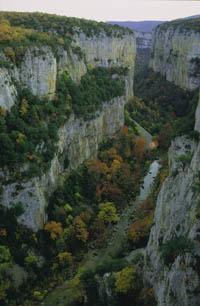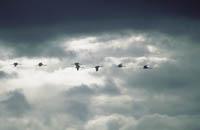New Bestizaleon November

As for the animals, November is the month before the winter, so it is very important. We adapt the migrants on the journey or in the places where the winter is going to pass, and those who have stayed there, involved in the last preparations to face the worst months. And it is fitting to be prepared because the first winter attack can come at any time.
Nests of pine honey
Once again, the pines have begun to be filled with white nests. These silk nests are the winter dens made by the pine caterpillars. Some of the regions of Euskal Herria are populated with pine trees, so these bugs that feed on pine leaves have a great opportunity to become a plague that causes damage of a certain magnitude. Among the anti-beldar systems, one of the most used is the fight with insecticides launched from the plane. However, before going to these chemicals, we can try to cut and burn nests, place boxes for birds and bats, use pheromone traps, etc., without a doubt, preventing plague is the best way to fight.
Trout racket
Towards November-December the trout will go to regattas with clean water and rocky bottom. Many of them have been in the lower part of the river throughout the year, but as the time of reproduction approaches, they will go up the rivers. There are areas in which the current is strong, but the instinct of reproduction of the trout is stronger and blindly will go up overcoming all the obstacles. Finding an appropriate stretch of river, they will look for some quiet place to prepare the area to burn. To do this, the female opens a hole in the sand and gravel, with a blow of mud, where she puts a lot of eggs. The male, next to him, pours the seed to fertilize the eggs. Once the piece is covered with stones, the adults will let the currents be carried to return to their places of origin.
Migration is still ongoing

The migration of birds continues and although at the beginning of the month there may be great passes, as the day advances the movement will decrease. Up to 8-10 can be seen a large dove pass, but from there it is difficult. The foxes can also pass along the north and with them, arabazos, potters, cantilevers, geese, cranes, etc. The latter are simple bustling and their cries are heard at a huge distance, so we usually hear we realize the passage of the cranes. During these weeks there are great movements of day and night and can offer a great show.
Following with the migrants, November is the month of the scholarship. This colluco of the forests hides in the jungle and with a little luck, we get up from the legs and flee in a naughty flight, losing in the horn section. In the reservoirs of the area of Vitoria-Gasteiz, in Urdaibai, Txingudi, Baiona or in the wetlands of Navarre, there are numerous wintering birds. Normally the density of these birds is directly related to time. Thus, fleeing from the cold northern territories, with inclement weather and cold environments are much more concentrated in the surroundings.
Grouped together
Although the winter is approaching, many animals tend to meet in groups. It is not difficult to see deer, deer, rebecos in small groups or in enough squares. Many species of birds also gather in groups, allowing them to find fodder and escape dangers. Thus, when several specimens are collected, the eyes saturated
or to detect predators or other dangers and to escape. Likewise, at this time they can be in groups, among others, reptiles and amphibians in underground graves, bats, old chambers, caves and caves, willing to initiate hibernation.
Looking at the aquatic myrtle
However, we will not see water cells. And it is a bird that normally travels alone or in couple. However, as for the rest, winter is not easy for the aquatic myrtle. This txuribelza bird of the streams is an excellent hunter of underwater bugs, but when floods occur it becomes more difficult to find hunting pieces in the bottoms. Mortality in the coming months will be high and according to experts, only 20% of the offspring born a year will arrive in spring.
Zeal of the Sarrios

The first snows have reached the highest peaks of Euskal Herria. There are the freshly peeled mountains of the area of Belagua, where the male sarrios have been put to the leg. Now the zeal has reached them and the females try to cover it. Once the females are reunited, in addition to matching them with them, the males who approach with the same intention must escape again and again. The men, of course, end up down and if suddenly time gets worse and they are trapped by a bad snowfall, many of them will pass. In these cases, having acquired more wood in reproductive times, the male dies more than the female.
Land in gardens

It is a good day to approach today to the orchard and to take home the cabbages and carrots that are about to meet. Forcefully pulling the leaves of the first carrot ...nothing? What demons have happened here? Let's go to the side and so on! In view of the holes around me it has not been difficult to find the culprit. Four of the six beautiful carrots have eaten me the land. In winter, when it has little to do with the surroundings, it approaches the gardens and steals carrots, weavers, beets, etc. Delicious, she likes to try them all to then eat the richest.
The prevention of this rodent is not easy and farmers use strains for hunting or satain herbs to get away from the surroundings. Others choke the holes with water to remove and catch the land. In any case, it is very difficult to control these diablillos and, if not, do not leave the vegetable that is at tomorrow's meeting point.
Published in 7
Buletina
Bidali zure helbide elektronikoa eta jaso asteroko buletina zure sarrera-ontzian











